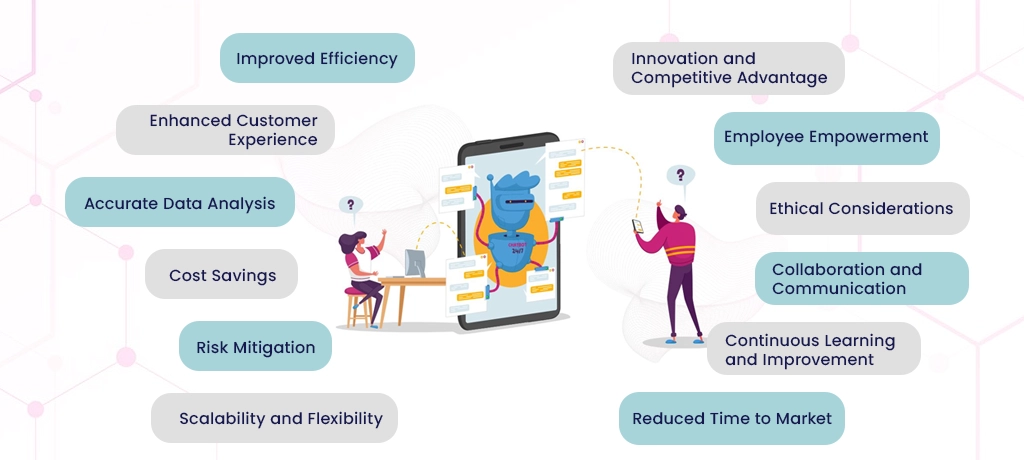Table of Contents
AI prompt engineering refers to the process of formulating questions, guidelines, examples, and constraints. It can frame problems and tasks for AI systems. The way organizations craft the inputs and instructions fed into AI models is known as prompts. It shapes the performance, impact, and value of those systems. Effective AI prompt engineering optimizes prompts to produce outputs that are useful, safe, and aligned with business goals.
Through iterative refinement of prompts based on AI model output, organizations can continually improve the value generated from their AI investments over time. When prompts are engineered correctly, AI systems can deliver a range of benefits for businesses. It includes increased efficiency, reduced risks, higher revenues, and competitive advantages. Well-designed and optimized prompts guide AI toward solutions that solve real problems and avoid common pitfalls. It also helps organizations achieve their strategic objectives. Choose the leading prompt engineering consulting services company to help with writing optimized prompts for the business.
Key Benefits of AI Prompt Engineering
AI prompt engineering optimizes how problems are posed to AI systems to produce more useful outputs aligned with organizational goals. Effective AI prompting unlocks numerous benefits for businesses by translating raw AI capabilities into practical solutions that create value. The improvements fall into areas like efficiency, accuracy, innovation, and ethics. Prompt engineering services help improve AI models in multiple ways:

Improved Efficiency
AI prompts can be designed to assist AI systems in producing output and resolutions that are noticeably more effective. AI models may narrowly focus on the most pertinent elements and inputs to determine the most advantageous courses of action. Carefully formulated queries and instructions help in this process. Systems can get to sound conclusions and courses of action more rapidly as a consequence of less unnecessary study and evaluation of irrelevant tangents.
Minor adjustments to the prompt engineering services, for instance, can assist the AI focus on the largest pain areas and chances for efficiency benefits. Businesses can get productivity advantages linked to optimized AI prompts thanks to AI outputs that require less human inspection and additional analysis. The time it takes for an organization to get value from its AI investments is reduced as a result of employees spending less time analyzing excessive AI output. It also helps to put the most valuable insights into practice.
Enhanced Customer Experience
When properly triggered, AI technologies used for customer interactions may significantly enhance the customer experience. These artificial intelligence (AI) apps better grasp client demands overall and produces more helpful replies thanks to carefully designed training data and instructions. The possibility that a customer issue will be resolved at the first encounter can be increased when AI models are triggered with the company’s goals for the customer experience in mind.
Higher customer satisfaction ratings and a decline in unfavorable sentiment result from this. For instance, a virtual assistant employed for technical assistance that emphasizes clarity, civility, and fixing the customer’s underlying issue is likely to increase consumer impressions of the virtual assistant and even the whole brand. Proper prompt engineering services direct the AI to give clients the most beneficial and pertinent information possible. It helps in increasing customer loyalty and favorability for the company.
Accurate Data Analysis
AI prompts that have been carefully designed can assist AI systems conduct data processing tasks with fewer mistakes. The quality and dependability of the insights produced by AI models while analyzing data may be greatly enhanced. It helps in developing the correct questions, examples, and guidelines. Reduced assumptions, emphasis on key details, and a preference for accuracy over speed produce analyses, projections, and recommendations from AI that is more likely to be accurate. You may lessen overestimation and underestimating mistakes. For instance, by asking an AI system used for sales forecasting to take into account certain product life cycles, seasonal trends, and competitor activities.
Businesses achieve AI-driven reports, warnings, and productivity suggestions they can truly rely on and use with confidence. It helps in carefully defining the context and concentrating the AI on what matters most for the analysis work at hand. Better decision-making, less risk, and higher assurance regarding AI outputs are all a result of enhanced accuracy. Prompt engineering services are an efficient approach for AI models to structure raw data in a way that directs them toward correct and true analysis. Eventually providing organizations with the exact insights required to make critical choices.
Cost Savings
Organizations get rapid cost benefits from their AI investments when AI systems can generate accurate, relevant, and efficient outputs right away. It saves money when there is less need for human inspection, auditing, and retraining of flawed AI models. Properly designed AI prompts that decrease false positives, unnecessary analysis, and inaccurate suggestions. It results in less wasted AI processing, less duplication of effort, and fewer expensive errors. Businesses can also see continuing cost reductions by making better decisions that are supported by more trustworthy AI insights. Costly mistakes resulting from subpar AI analysis are less likely, and AI-recommended optimized procedures and workflows. They are more likely to produce real returns.
Overall, well-designed prompts used by AI systems to generate value from the first day of usage result in higher ROI, shorter payback times, and reduced total cost of ownership for AI technology. Organizations may prevent unnecessary investments down the road that frequently come with poorly performing early AI implementations. It helps in conducting proper AI prompt engineering up front.
Initial AI prompting improvements make a significant contribution to ensuring that AI systems immediately produce the cost-effect this combination produces. Neither humans nor artificial intelligence could produce these combinations on their own.
Risk Mitigation
AI system output that is inaccurate, deceptive, or untrustworthy can put enterprises in danger. Organizations may minimize these AI risks from the outset with the use of well-designed AI prompts that generate precise and reliable insights. The probability that flawed AI analysis would result in unsafe conclusions is reduced by prompts that avoid unintentional biases. It also draws attention to significant exceptions and limits AI models to logical outputs. Prompt engineering service companies are less likely to advise unsafe courses of action based on inadequate or biased data analysis. They are instructed to pay attention to hazards and appropriate safety measures.
Regulatory compliance and threat models are just a few examples of prompts that direct AI models toward more risk-averse answers. The final result is AI-driven judgments, alerts, and suggestions that organizations can rely on to reduce their exposure to legal obligations. It also helps manage monetary losses, reputational damages, and other negative effects. Organizations may include crucial risk controls and risk-averse mindsets in how challenges are framed for AI from the beginning. AI solutions are produced as a result of this methodical risk minimization. Prompt engineering services complement an organization’s current risk management procedures and control environment rather than making them worse.
Maximize AI Potential with Expert Prompt Strategies
Scalability and Flexibility
With the use of well-developed AI prompts by a prompt engineer, enterprises may expand and reuse their AI investments. AI models may be utilized to tackle novel use cases and commercial difficulties more rapidly. It is utilized when given domain-neutral instructions that highlight broad patterns and logical links. Higher levels of abstraction excite AI systems, allowing them to grow into more flexible tools. It may be used across an enterprise. To find opportunities for optimization in other unrelated processes, for example, it is more practical to use an AI model. It has been trained to find inefficiencies in one business process using broad signals rather than context-specific data.
The scalability of AI technology enables organizations to employ it more productively. Prompt engineering AI allows for scalable AI solutions that can be easily adapted for specific groups and business units. It helps in enabling flexible deployment across divisions. Well-crafted and adaptable prompts allow organizations to organize templates. It can be customized and extended for various AI applications. This scalability supports an organization’s long-term AI strategy by striking a balance between standardized AI platforms. It is beneficial for the whole organization with customized solutions tailored to different teams and uses cases.
Well-optimized prompt engineering services facilitate AI solutions that scale across the business while retaining the flexibility needed to meet the unique requirements of particular divisions, departments, and user groups. The result is AI that is flexible enough to supplement existing business processes and workflows. It is achieved while also remaining practicable at an enterprise scale.
Innovation and Competitive Advantage
Properly engineered AI prompts enable faster innovation cycles and provide businesses with sources of sustainable competitive differentiation. AI systems prompted us to think creatively and consider previously unexplored problems and opportunities. It helps spur new product and service concepts. When prompted to challenge existing assumptions and think beyond industry norms, AI can generate fresh strategic insights. It grows an organization’s competitive advantage. AI prompted with goals of breakthrough value creation can reveal innovations that disrupt incumbents and reshape industries.
The improvements in AI output and performance unlocked by prompt engineering AI also allow businesses to harness emerging AI capabilities. They can achieve it before competitors and realize economic benefits ahead of the curve. Organizations powered by optimized AI prompting gain a multi-year innovation lead over laggard companies. Leveraging AI-generated ideas to develop novel business models, operating processes, and data applications can help in achieving this objective. Over time, these transient advantages from better-engineered AI become sources of enduring competitive differentiation.
Employee Empowerment
When AI systems are engineered to provide useful insights and recommendations that complement human work, employees feel more empowered and able to perform at their best. AI helps employees focus on higher-value tasks while letting AI handle routine work. Prompts that frame AI outputs as recommendations instead of directives give employees the autonomy and discretion to determine how AI insights should be applied. Prompt engineering consulting services empowering dynamic help workers utilize AI solutions in a way that best leverages their unique skills, experiences, and judgment.
Employees are more productive and motivated when AI frees them from tedious activities yet still allows for human oversight, discretion, and creativity. Additionally, AI prompted with goals of augmenting workers instead of automating jobs. It provides a less threatening solution that gains more employee buy-in and trust. Workers feel more valued when they understand how AI will make their roles more meaningful and impactful. Ultimately, proper prompt engineering fosters an environment where employees view AI as a tool that enhances the value of human work and the capabilities of human workers.
Ethical Considerations
How issues are phrased and inquiries are put into AI systems is where ethical AI starts. By eliminating prejudice, maintaining transparency, and putting a priority on justice and accountability from the start, optimized AI prompting creates an ethical basis. AI models are guided to behave ethically robustly by prompts that limit AI outputs to morally sound solutions. It also draws attention to possible harms and unjust effects and describes values-aligned goals. To influence how AI systems interpret issues and approach solutions, broad ethical values. These values include safety, accountability, inclusion, and openness may be included in AI prompts by a prompt engineer.
Companies that use AI prompting to establish ethical preferences and non-negotiable limitations surrounding AI outputs see a decline in unethical AI behaviors such as discriminatory insights, inappropriate AI suggestions, and other forms of unethical AI behavior. To prevent damage once AI systems are operational, ethical AI governance and oversight practices must be carefully engineered into AI prompts to line with an organization’s ethical code. Businesses weave ethics into the way AI perceives and interprets the environment from the very beginning by taking ethics into account while designing AI prompts.
Collaboration and Communication
When AI prompts are designed properly, they may significantly enhance how AI systems interact with humans and work together. AI may provide outputs that are simple for people to understand and use by using optimized prompting. It identifies preferred communication styles, crucial situations, and essential comprehension indications. Human collaborators accept and use AI systems more readily when they are asked to produce explanations, reasons, and suggestions in plain, jargon-free language. The way that AI models communicate and reply is shaped by prompts that prioritize interactive dialogue and two-way communication. Prompt engineering services companies enable more natural interactions between AI and people.
As a result, AI improves collaboration by assuring comprehension, elucidating ambiguities, and customizing communication depending on input from human partners. Optimized prompting also creates a better alignment between human and AI cognitive processes. It paves the way for the effective fusion of human and AI knowledge. This combination produces results that neither humans nor artificial intelligence could produce on their own. By facilitating true collaboration between artificial and human minds, AI may be used as a tool to improve teamwork and collective intelligence.
Continuous Learning and Improvement
With the aid of efficient AI prompting, AI systems may continuously learn and improve. AI may incorporate new information into how challenges are understood and approached. It is achieved by employing prompts that allow for modification and improvement based on new knowledge and feedback. AI models with an open mind and a growth mindset aggressively look for opportunities to learn from mistakes, extraordinary circumstances, and counterexamples. It also highlights flaws in their decision-making processes.
This curiosity and thirst for improvement led to even better results the following time. Through a series of feedback loops and an optimization process led by optimal prompting, initially, poor AI outputs eventually reach human-level performance. Optimized prompt engineering services define business issues for AI in this way to expose limitations in current AI capabilities. It can establish the foundation for an iterative learning process encompassing investigation, testing, and optimization.
The adaptive, evolutionary method of problem-solving used by AI prompts ensures that AI systems will always get smarter and more valuable. The end consequence is a continual cycle of rapid engineering advancement and AI that gives businesses cumulative benefits over time.
Reduced Time to Market
The time needed to realize profits from AI investments is reduced by AI systems that may produce useful outputs immediately after deployment. A quicker time to market for innovative AI-powered goods and services results from AI models. It provides immediately helpful recommendations, insights, and solutions upon deployment due to optimized prompting. AI systems by a prompt engineer may deliver value sooner rather than later if they are designed from the beginning to produce outputs. It seamlessly integrates into current workflows and processes. Properly designed prompts enable AI models to get started quickly and generate results that require little in the way of human calibration, retraining, or reminding.
Organizations may deploy new AI applications more quickly and begin reaping the benefits of the solutions thanks to this speedy functionality. Faster iteration cycles throughout the development process are also a result of optimized prompting. This is because high-performing AI systems can be developed by a prompt engineer with less trial and error. AI models advance more quickly towards providing useful outputs when given examples, training data, and objectives that are properly tailored to the desired conclusion. Furthermore, effective re-prompting based on early feedback following the original launch speeds up and simplifies the implementation of any necessary revisions.
Because of this, the time it takes to convert AI investments into practical productivity improvements and competitive advantages is shortened by AI systems that are designed with optimized prompting.
Looking for a prompt engineerig company
Get in touch with A3Logics
Environmental Impact of Prompt Engineering Techniques
Due to the enormous quantities of energy and resources needed to develop, deploy, and constantly enhance AI models, improper or unrestrained usage of AI systems might have a harmful influence on the environment. However, organizations may reduce their environmental impact by using optimized AI prompting that limits AI outputs to eco-friendly, sustainable solutions. AI establishes sustainability goals, places an emphasis on reducing material waste, and limits outputs to ecologically positive outcomes.
AI systems concentrate on enhancing efficiency, cutting consumption, and dematerializing processes in a sustainable way when asked to take into account elements. These elements include carbon emissions, resource depletion, and pollutant creation. When sustainability is included in the way challenges are framed for AI, optimized AI outputs like eco-friendly manufacturing and logistics plans become more possible. The final result is innovation fueled by AI that takes place within the parameters of the earth and societal foundations for sustainability.
Businesses can make sure that their AI investments amplify, not hasten, the shift to an ecologically sustainable economy by careful prompt engineering techniques. An ethical requirement to take sustainability into account is established by optimized AI prompting, which AI systems later internalize as a fundamental design tenet.
Conclusion – Benefits of AI Prompt Engineering
Numerous advantages of AI prompt engineering enable businesses to get a better return on their AI expenditures. Optimized prompting enables gains across people, processes, and products, from cost savings and risk reduction to innovation and competitive advantage. The way issues and tasks are structured for AI systems as it develops in power will determine whether AI enhances or hinders our companies, society, and planet. Organizations can make sure their AI assets deliver outputs that create value responsibly and inclusively by carefully designing AI prompts based on concepts like transparency, ethics, and sustainability. To maximize AI’s promise while lowering its hazards, effective AI prompt engineering is essential.
FAQ – Benefits of AI Prompt Engineering
What Is AI Prompt Engineering?
The act of creating the questions, rules, examples, and limitations that are used to frame issues and tasks for AI systems is referred to as AI prompt engineering. The output, performance, and influence of these AI systems are determined by how organizations organize the inputs and instructions supplied into AI models, known as prompts.
Effective AI prompt engineering refines prompts to generate results that are precise, effective, secure, and in line with corporate objectives. To continuously enhance AI outputs over time, entails repeatedly modifying prompts depending on the performance of AI models. AI prompt engineering is an important but sometimes disregarded component of developing, implementing, and expanding effective AI solutions.
Why Is It Important To AI?
AI prompt engineering is crucial because how issues and tasks are presented to AI systems ultimately affects their outputs and performance. Artificial intelligence models tend to generate random, unclear, or irrelevant responses in the absence of adequately designed cues. AI is directed towards results that match organizational objectives and needs by prompts that have been optimized. AI prompt engineering makes sure AI systems concentrate on the proper factors, eliminate avoidable mistakes, and deliver practical results for organizations straight away.
Effective prompting serves as a filter, transforming undeveloped AI capabilities into products that benefit organizations. As organizations turn to AI for additional strategic advantages, the necessity of AI prompting increases because optimized AI outputs made possible by effective prompting unleash many advantages beyond basic functionality.
What is the importance of prompt engineering in AI?
Prompt engineering is important in AI for several reasons:
AI models are only as good as the information and guidelines provided to them. Prompt engineering is crucial because it influences how AI systems comprehend issues, examine information, and come up with answers. The contribution of Prompt optimization is the creation of accurate, dependable, and goal-aligned AI outputs.
Optimal prompts steer AI models towards high-value outputs right away, necessitating minimal monitoring and improvement from humans. AI systems may operate consistently across a range of inputs and circumstances thanks to well-designed prompts. Domain-neutral rules and patterns encourage AI to develop into more scalable and adaptable technologies.
Rapid development results in ongoing AI advancement throughout time. AI systems can advance over time by using refined prompts that include lessons learned. In conclusion, quick engineering is crucial to reap the full rewards of AI by converting undeveloped AI capabilities into workable solutions through good issue framing and guidance. It serves as a link between AI impact and potential.
Why Is Prompt Engineering Essential for Organization’s Success?
AI solutions are guaranteed to offer valuable outputs that aid in achieving corporate objectives via effective quick engineering. AI models that are constructed and trained correctly from the beginning produce insights, suggestions, and actions that help the organization.
By concentrating models on efficiency, accuracy, and minimizing wasted effort, well-designed prompts direct AI towards productivity increases and cost reductions. This enables an increase in the ROI of AI investments.
Optimized prompting makes models more adaptable and independent of specific domains. This enables organizations to expand and easily reuse AI across divisions. A company may truly trust and confidently use AI outputs produced by prompts that instill ethical and risk-aware mindsets. This promotes ethical innovation while reducing possible damage from AI.
A positive feedback loop in which AI systems steadily increase organizational capacities is enabled through prompt improvement. Long-term competitive advantages are driven by ongoing AI advancement.
Rapid engineering transforms untapped AI potential into workable solutions that strengthen an organization’s personnel, systems, and output. When done correctly, it is essential to use AI in a way that significantly benefits the company’s bottom line.






